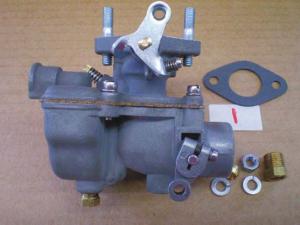2016 - Volume #BFS, Issue #16, Page #06
[ Sample Stories From This Issue | List of All Stories In This Issue | Print this story
]
Cub Carburetors Restored To “Better Than New”
 |
“Anybody can claim to rebuild a carburetor by replacing some gaskets, seals and a few other parts and try to reset the float,” says Finch. “I use new, original design parts and some that are very hard to find.”
Finch is retired from the automotive industry. He collects Farmall Cubs and describes himself as a Cub carburetor fanatic. He refers to Cub carburetors as “delicate little jewels” and treats them accordingly.
“I have 7 special jigs designed and machined to my specifications for use restoring carburetors,” says Finch. “I even have a special tool kit manufactured in England that is designed to replace the 4-48 threads for the idle pickup tube.”
Finch says at least 70 percent of the carburetors he receives have the idle pickup tubes broken off at the top. “It’s a very delicate process to remove the broken off tubes, especially after people try to dig them out of the carburetor top,” he says.
When Finch finishes, nearly every part of the carburetor has been replaced with original parts. Only the bowl and the top remain. The cover and bowl mating surfaces are machined flat for a perfect fit and connected with four new stainless steel Fillister screws and lock washers. The manifold mounting surface is also machined flat and level with correct-sized studs to mount the carburetor to the manifold.
A one-of-a-kind jig is used to level carburetor tops where they meet the intake manifold. Finch had it milled out of a 45-lb. solid metal block to be within 0.001-in. of flat and perfectly square.
Finch explains that the mounting surface on a carburetor warps into a U-shape over time and sucks air in between the carburetor and gasket. This causes a severely incorrect fuel/air ratio, equating to hard starting, loss of power, improper idling and more.
“The carburetor mounting surface must be level and parallel to the engine,” he says. “After leveling the top-to-bowl surface, I then put the carburetor top into the jig to mill it.
“I have another jig that lets me drill, tap and Heli-Coil the carburetor mounting stud threads,” he says. “Then the jig rotates 90°, and I use a special drill and tap for new threads of the fuel inlet port.”
All threads are replaced with Heli-Coil stainless steel replacement threads. Finch says he has a one-of-a-kind drill and tap to Heli-Coil the fuel inlet threads and bring them back to absolute standard thread without hitting the ferrule boss down inside the fuel inlet port.
“About the only things that can’t be fixed are the bowl bottom drain plug threads,” says Finch. “These are ‘pipe-plug’ threads, and there are no known replacement Heli-Coil threads.”
He warns against jigs offered on the internet that claim to flatten the carburetor. He says that suggesting washers and C-clamps can be used to bend a carburetor simply won’t work. Warped surfaces need to be machined to specifications.
Finch promises to have carburetors from Cub owners back in the mail within two to three days of receipt, insuring the restored carburetors for $300. Postage and insurance run $16.40 with no handling fees. Restoration runs from $168.88 to $188.72.
“I get carburetors shipped to me from all over the U.S.,” says Finch. “It’s mostly word of mouth from one Cub collector to another.”
Contact: FARM SHOW Followup, Michael G. Finch, 2530 Meadowood Lane, Milford, Mich. 48380 (ph 248 684-4029; Fixitmike1@aol.com).

Click here to download page story appeared in.
To read the rest of this story, download this issue below or click here to register with your account number.




